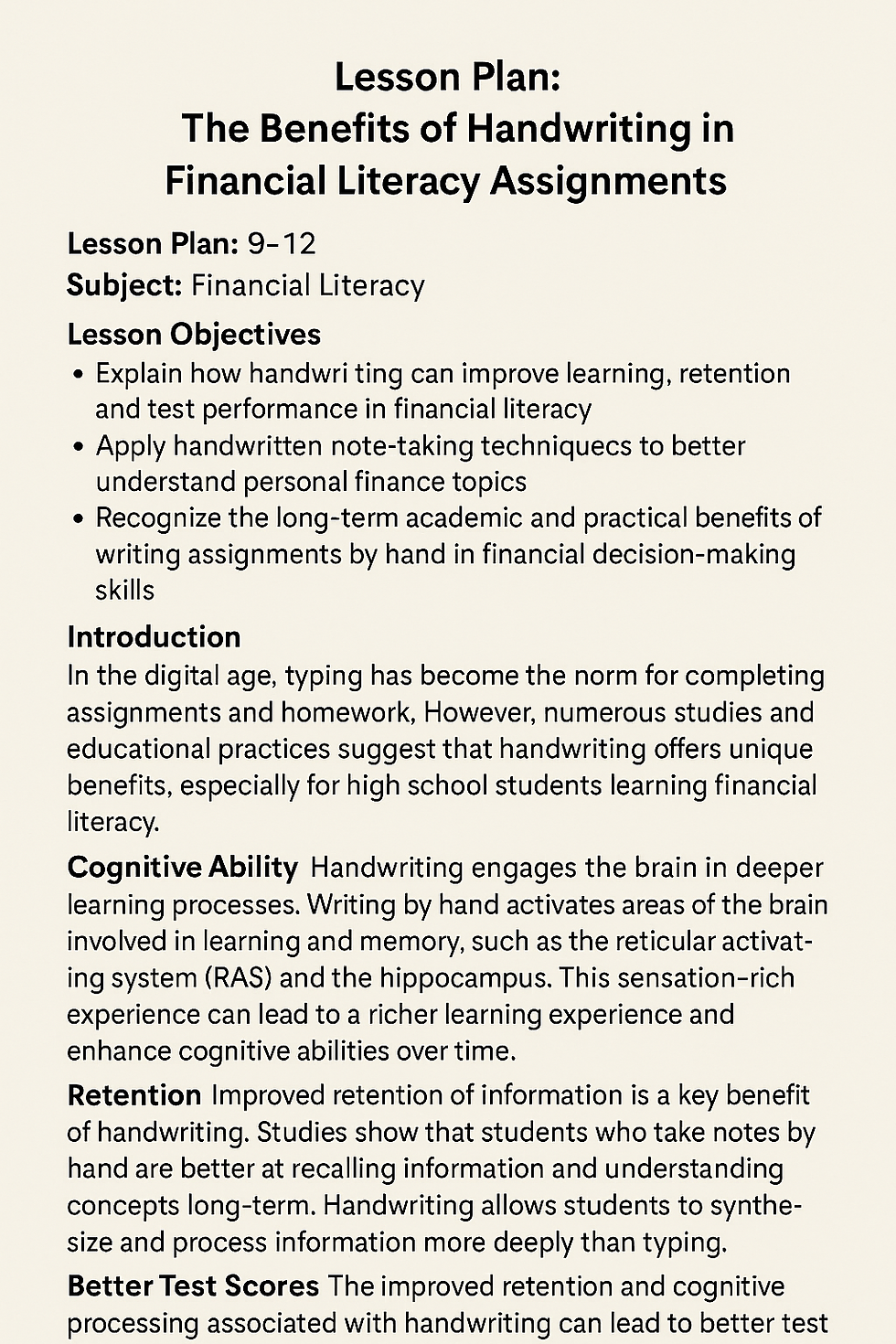Lesson Plan: The Benefits of Handwriting in Financial Literacy Assignments
- The Chairman

- Aug 12
- 2 min read

Lesson Plan: The Benefits of Handwriting in Financial Literacy Assignments
Grade Level: 9–12Subject: Financial LiteracyDuration: 50–60 minutesFlorida State Standards Alignment:
SS.912.FL.1.2 – Explain the importance of taking responsibility for personal financial decisions.
SS.912.FL.3.3 – Explain the relationship between spending, saving, and investing.
ELA.K12.EE.3.1 – Make inferences to support comprehension.
ELA.K12.EE.5.1 – Use the writing process to develop, strengthen, and publish writing.
Lesson Objectives
By the end of this lesson, students will be able to:
Explain how handwriting can improve learning, retention, and test performance in financial literacy.
Apply handwritten note-taking techniques to better understand personal finance topics.
Recognize the long-term academic and practical benefits of writing assignments by hand in financial decision-making skills.
Materials Needed
Pen and notebook (no laptops or tablets for this activity)
Example financial literacy assignment (budget creation, debt payoff plan, or savings strategy)
Whiteboard or projector for teacher notes
Lesson Outline
1. Introduction (10 minutes)
Begin with a discussion: “When you take notes, do you usually type or handwrite? Why?”
Share key points from the introduction of the provided article, emphasizing how handwriting stimulates deeper cognitive processing.
Connect to financial literacy: explain that complex topics like budgeting, investing, and credit management require strong retention and analytical thinking.
2. Direct Instruction (15 minutes)
Cognitive Ability: Explain how handwriting engages more areas of the brain, enhancing comprehension of complex topics like compound interest or investment risk.
Retention: Share research showing handwritten notes improve recall — crucial when preparing for ESB certification or financial decision-making.
Test Scores: Discuss how better recall leads to stronger performance on both school exams and real-world applications (like calculating interest rates, interpreting loan offers).
3. Guided Practice (15 minutes)
Students will handwrite a short financial plan:
Create a monthly budget with income, expenses, and savings goals.
Write a short paragraph explaining one financial decision they would make differently after learning about budgeting.
Emphasize rewriting and rephrasing financial terms in their own words to deepen understanding.
4. Independent Practice (Homework)
Assign students to complete a handwritten financial analysis of a personal finance topic (e.g., “Pros and Cons of Credit Cards” or “How to Save for a Major Purchase”).
Encourage them to use drawings, charts, and bullet points for organization.
5. Assessment (5 minutes)
Review a few examples of student work in class.
Provide feedback on clarity, comprehension, and effort in note-taking.
Explain that handwritten notes will be used for a quiz review session, reinforcing the retention benefits.
6. Conclusion (5 minutes)
Recap how handwriting connects to improved financial literacy learning.
Encourage students to incorporate handwritten practice into their study habits for better understanding and retention.
#FinancialLiteracy #StudentSuccess #HandwritingMatters #NoteTakingSkills #HighSchoolFinance #MoneySmartTeens #StudyTips #CognitiveBenefits #BetterTestScores #BudgetingSkills #TeenFinance #HandwrittenNotes #LearnByWriting #bobsuttonbroward #chairmanbobsutton



































Comments